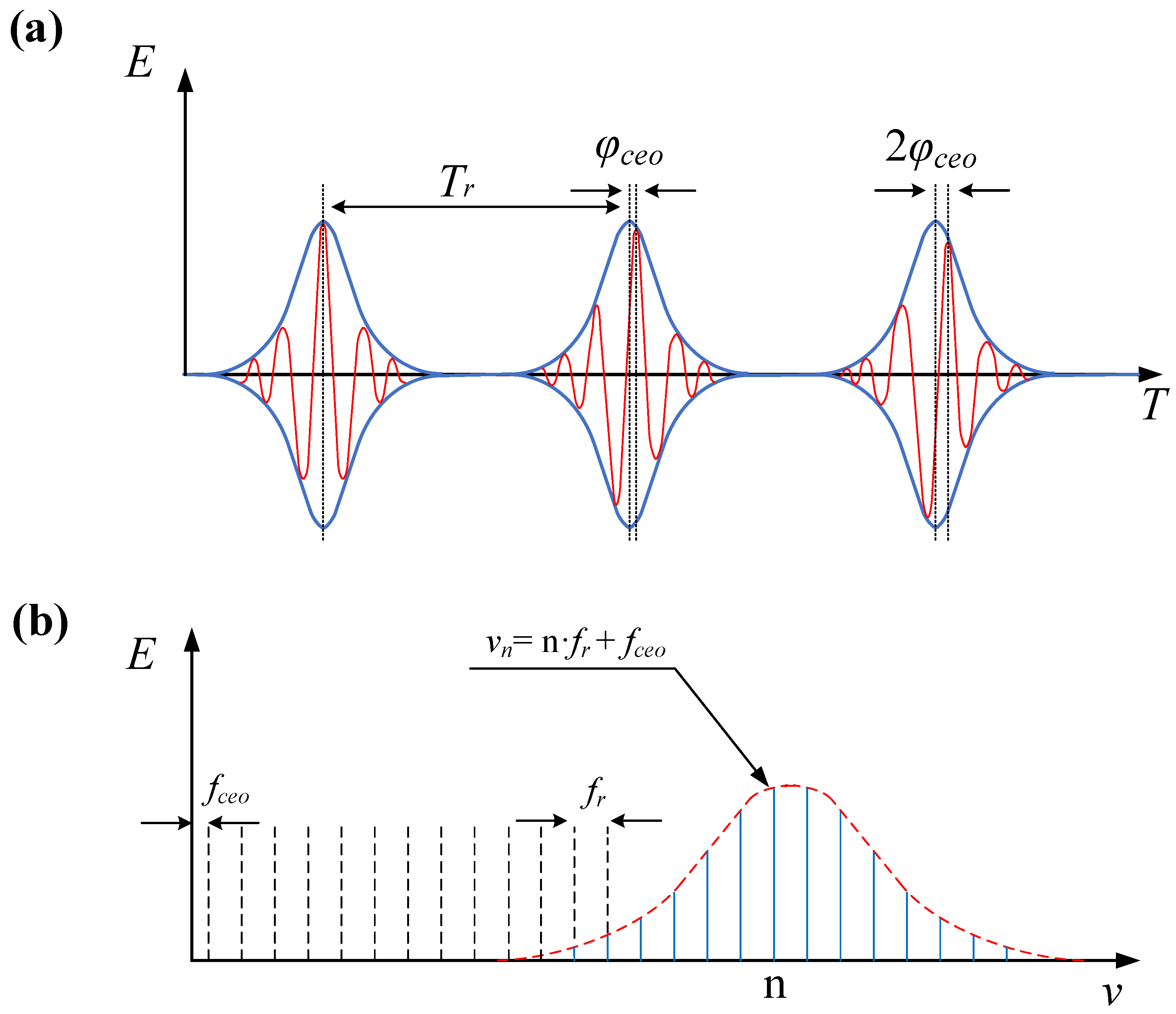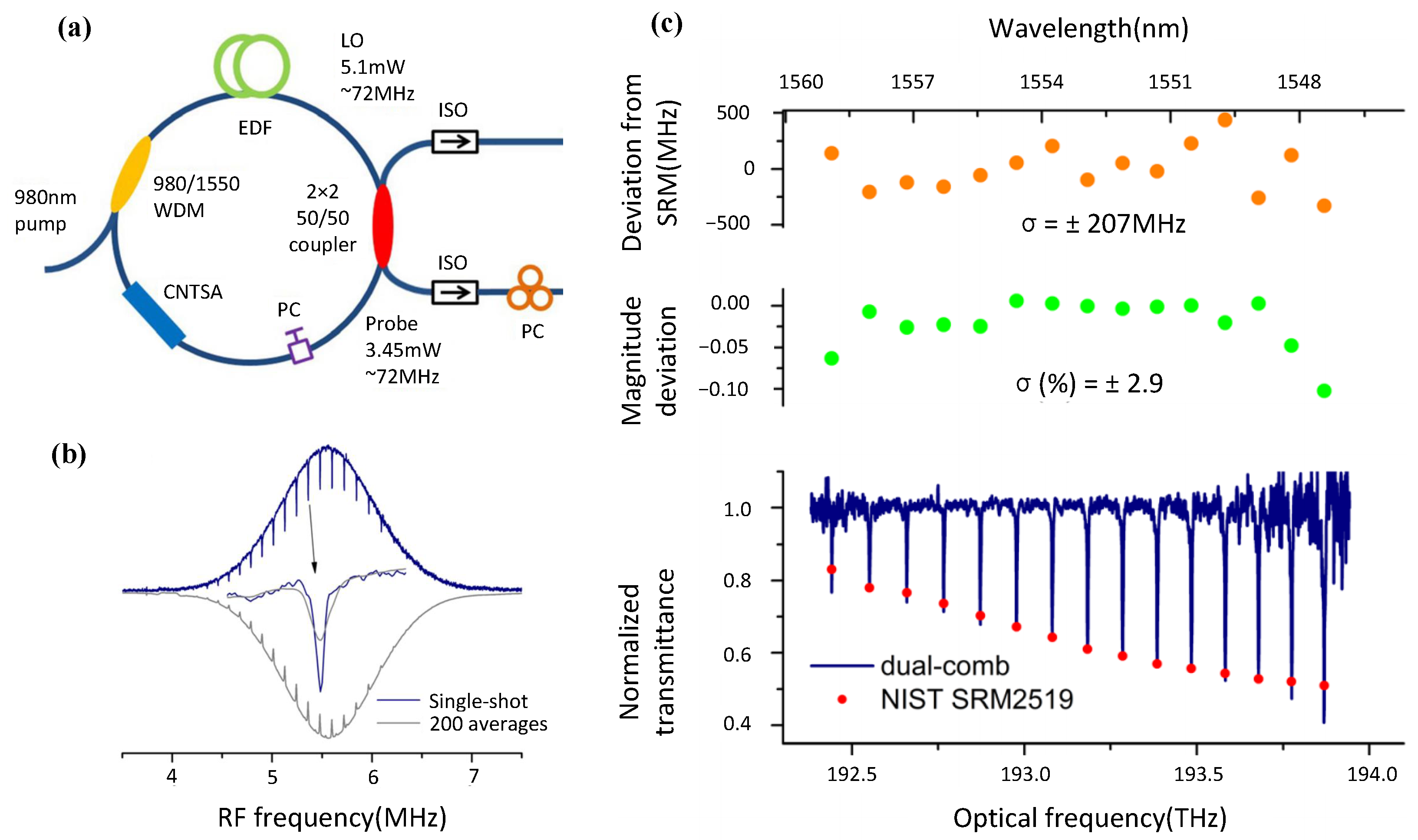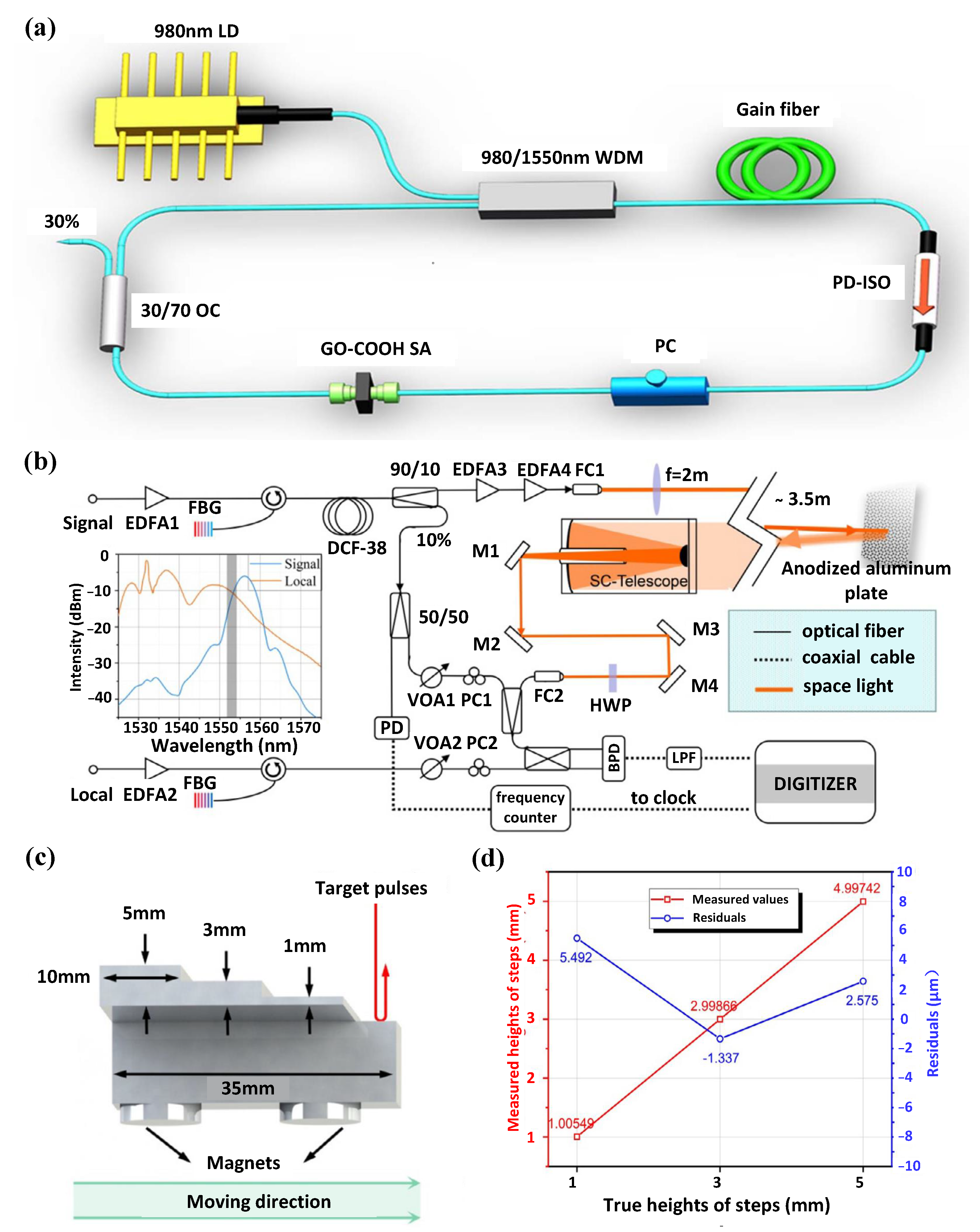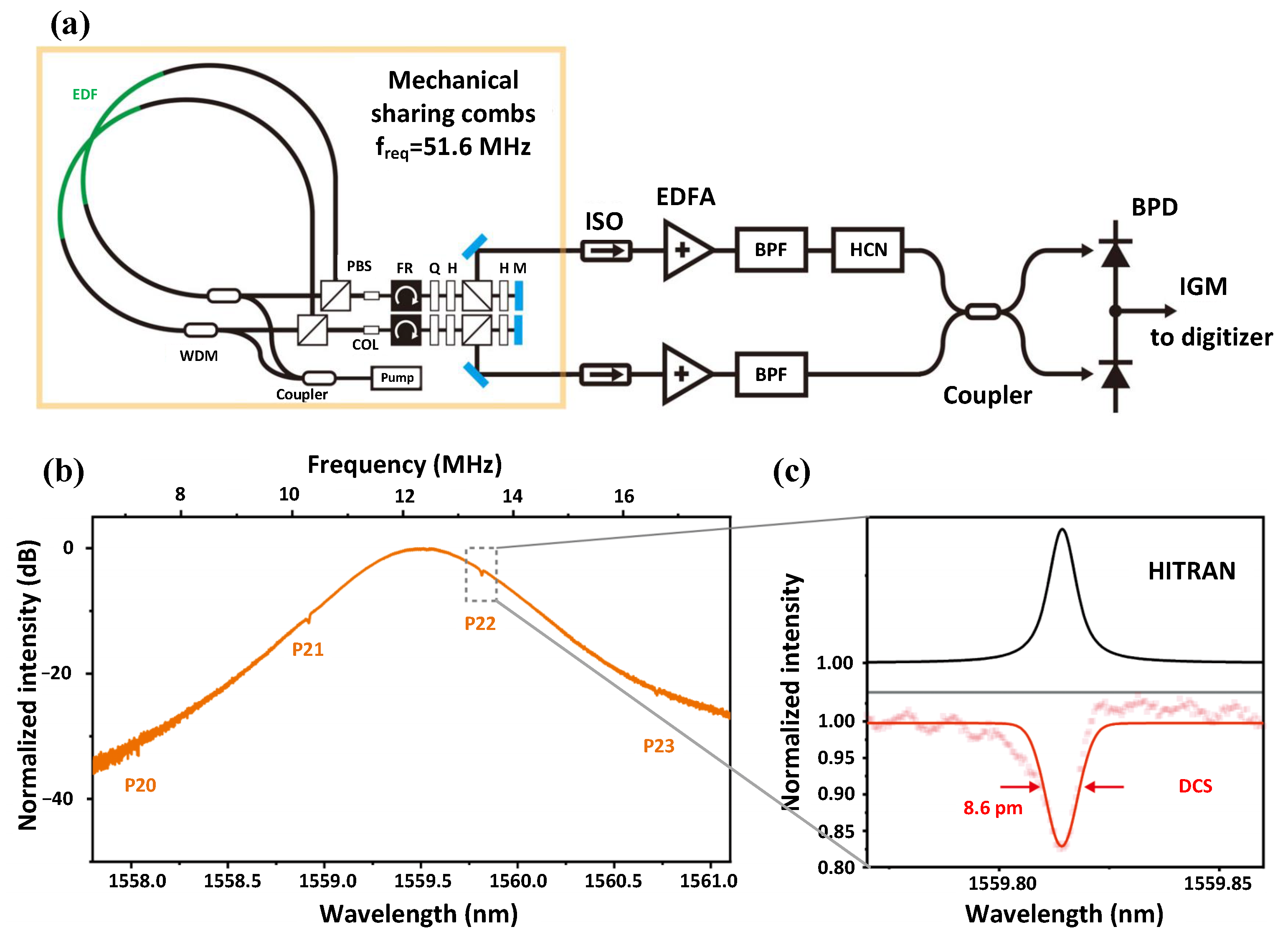Recent Advances and Outlook in Single-Cavity Dual Comb Lasers
Abstract
1. Introduction
2. Principles of Optical Frequency Comb and Dual-Comb Spectroscopy
2.1. Principles of the Optical Frequency Comb
2.2. Principles of the Dual-Comb Spectroscopy
3. Single-Cavity Dual-Comb Systems
3.1. Bidirectional Single-Cavity Dual Combs
3.2. Single-Cavity Dual Combs Based on Wavelength-Multiplexing
3.3. Single-Cavity Dual Combs Based on Polarization-Multiplexing
3.4. Single-Cavity Dual Combs Based on Space-Multiplexing
4. Applications
5. Conclusions and Perspectives
Author Contributions
Funding
Institutional Review Board Statement
Informed Consent Statement
Data Availability Statement
Conflicts of Interest
References
- Maiman, T. Stimulated optical radiation in ruby. Nature 1960, 187, 493–494. [Google Scholar] [CrossRef]
- Hostetler, C.A.; Behrenfeld, M.J.; Hu, Y.; Hair, J.W.; Schulien, J.A. Spaceborne lidar in the study of marine systems. Annu. Rev. Mar. Sci. 2018, 10, 121–147. [Google Scholar] [CrossRef] [PubMed]
- Li, N.; Ho, C.P.; Xue, J.; Lim, L.W.; Chen, G.; Fu, Y.H.; Lee, L.Y.T. A progress review on solid-state LiDAR and nanophotonics-based LiDAR sensors. Laser Photonics Rev. 2022, 16, 2100511. [Google Scholar] [CrossRef]
- Palneedi, H.; Park, J.H.; Maurya, D.; Peddigari, M.; Hwang, G.T.; Annapureddy, V.; Kim, J.W.; Choi, J.J.; Hahn, B.D.; Priya, S.; et al. Laser irradiation of metal oxide films and nanostructures: Applications and advances. Adv. Mater. 2018, 30, 1705148. [Google Scholar] [CrossRef]
- Dutta Majumdar, J.; Manna, I. Laser material processing. Int. Mater. Rev. 2011, 56, 341–388. [Google Scholar] [CrossRef]
- Udem, T.; Holzwarth, R.; Hänsch, T.W. Optical frequency metrology. Nature 2002, 416, 233–237. [Google Scholar] [CrossRef]
- Kandula, D.Z.; Gohle, C.; Pinkert, T.J.; Ubachs, W.; Eikema, K.S. Extreme ultraviolet frequency comb metrology. Phys. Rev. Lett. 2010, 105, 063001. [Google Scholar] [CrossRef]
- Aiello, R.; Di Sarno, V.; Delli Santi, M.G.; De Rosa, M.; Ricciardi, I.; De Natale, P.; Santamaria, L.; Giusfredi, G.; Maddaloni, P. Absolute frequency metrology of buffer-gas-cooled molecular spectra at 1 kHz accuracy level. Nat. Commun. 2022, 13, 7016. [Google Scholar] [CrossRef]
- Pupeza, I.; Zhang, C.; Hogner, M.; Ye, J. Extreme-ultraviolet frequency combs for precision metrology and attosecond science. Nat. Photonics 2021, 15, 175–186. [Google Scholar] [CrossRef]
- Grelu, P.; Akhmediev, N. Dissipative solitons for mode-locked lasers. Nat. Photonics 2012, 6, 84–92. [Google Scholar] [CrossRef]
- Sun, Z.; Hasan, T.; Torrisi, F.; Popa, D.; Privitera, G.; Wang, F.; Bonaccorso, F.; Basko, D.M.; Ferrari, A.C. Graphene mode-locked ultrafast laser. ACS Nano 2010, 4, 803–810. [Google Scholar] [CrossRef] [PubMed]
- Fu, B.; Sun, J.; Wang, G.; Shang, C.; Ma, Y.; Ma, J.; Xu, L.; Scardaci, V. Solution-processed two-dimensional materials for ultrafast fiber lasers. Nanophotonics 2020, 9, 2169–2189. [Google Scholar] [CrossRef]
- Zhang, M.; Wu, Q.; Zhang, F.; Chen, L.; Jin, X.; Hu, Y.; Zheng, Z.; Zhang, H. 2D black phosphorus saturable absorbers for ultrafast photonics. Adv. Opt. Mater. 2019, 7, 1800224. [Google Scholar] [CrossRef]
- Zhao, X.; Jin, H.; Liu, J.; Chao, J.; Liu, T.; Zhang, H.; Wang, G.; Lyu, W.; Wageh, S.; Al-Hartomy, O.A.; et al. Integration and applications of nanomaterials for ultrafast photonics. Laser Photonics Rev. 2022, 16, 2200386. [Google Scholar] [CrossRef]
- Fu, B.; Sun, J.; Cheng, Y.; Ouyang, H.; Compagnini, G.; Yin, P.; Wei, S.; Li, S.; Li, D.; Scardaci, V.; et al. Recent progress on metal-based nanomaterials: Fabrications, optical properties, and applications in ultrafast photonics. Adv. Funct. Mater. 2021, 31, 2107363. [Google Scholar] [CrossRef]
- Wang, G.; Liu, T.; Chao, J.; Jin, H.; Liu, J.; Zhang, H.; Lyu, W.; Yin, P.; Al-Ghamdi, A.; Wageh, S.; et al. Recent advances and challenges in ultrafast photonics enabled by metal nanomaterials. Adv. Opt. Mater. 2022, 10, 2200443. [Google Scholar] [CrossRef]
- Fu, B.; Sun, J.; Wang, C.; Shang, C.; Xu, L.; Li, J.; Zhang, H. MXenes: Synthesis, optical properties, and applications in ultrafast photonics. Small 2021, 17, 2006054. [Google Scholar] [CrossRef]
- Cheng, Y.; Lyu, W.; Wang, Z.; Ouyang, H.; Zhang, A.; Sun, J.; Yang, T.; Fu, B.; He, B. MXenes: Synthesis, incorporation, and applications in ultrafast lasers. Nanotechnology 2021, 32, 392003. [Google Scholar] [CrossRef]
- Zhang, A.; Wang, Z.; Ouyang, H.; Lyu, W.; Sun, J.; Cheng, Y.; Fu, B. Recent progress of two-dimensional materials for ultrafast photonics. Nanomaterials 2021, 11, 1778. [Google Scholar] [CrossRef]
- Weber, R.; Graf, T.; Berger, P.; Onuseit, V.; Wiedenmann, M.; Freitag, C.; Feuer, A. Heat accumulation during pulsed laser materials processing. Opt. Express 2014, 22, 11312–11324. [Google Scholar] [CrossRef]
- Sugioka, K.; Cheng, Y. Ultrafast lasers—Reliable tools for advanced materials processing. Light. Sci. Appl. 2014, 3, e149. [Google Scholar] [CrossRef]
- Korte, F.; Nolte, S.; Chichkov, B.; Bauer, T.; Kamlage, G.; Wagner, T.; Fallnich, C.; Welling, H. Far-field and near-field material processing with femtosecond laser pulses. Appl. Phys. -Mater. Sci. Process. 1999, 69, S7–S11. [Google Scholar] [CrossRef]
- Varnavski, O.; Goodson, T., III. Two-photon fluorescence microscopy at extremely low excitation intensity: The power of quantum correlations. J. Am. Chem. Soc. 2020, 142, 12966–12975. [Google Scholar] [CrossRef] [PubMed]
- Vogel, A.; Venugopalan, V. Mechanisms of pulsed laser ablation of biological tissues. Chem. Rev. 2003, 103, 577–644. [Google Scholar] [CrossRef]
- Li, J.; Shang, C.; Rong, Y.; Sun, J.; Cheng, Y.; He, B.; Wang, Z.; Li, M.; Ma, J.; Fu, B.; et al. Review on laser Technology in intravascular imaging and treatment. Aging Dis. 2022, 13, 246. [Google Scholar] [CrossRef] [PubMed]
- Haus, H.A. Mode-locking of lasers. IEEE J. Sel. Top. Quantum Electron. 2000, 6, 1173–1185. [Google Scholar] [CrossRef]
- Essen, L.; Parry, J.V.L. An Atomic Standard of Frequency and Time Interval: A Cæsium Resonator. Nature 1955, 176, 280–282. [Google Scholar] [CrossRef]
- Hall, J.L. Nobel Lecture: Defining and measuring optical frequencies. Rev. Mod. Phys. 2006, 78, 1279. [Google Scholar] [CrossRef]
- Hänsch, T.W. Nobel lecture: Passion for precision. Rev. Mod. Phys. 2006, 78, 1297. [Google Scholar] [CrossRef]
- Diddams, S.A.; Udem, T.; Bergquist, J.; Curtis, E.; Drullinger, R.; Hollberg, L.; Itano, W.M.; Lee, W.; Oates, C.; Vogel, K.; et al. An optical clock based on a single trapped 199Hg+ ion. Science 2001, 293, 825–828. [Google Scholar] [CrossRef]
- Rosenband, T.; Hume, D.; Schmidt, P.; Chou, C.W.; Brusch, A.; Lorini, L.; Oskay, W.; Drullinger, R.E.; Fortier, T.M.; Stalnaker, J.E.; et al. Frequency ratio of Al+ and Hg+ single-ion optical clocks; metrology at the 17th decimal place. Science 2008, 319, 1808–1812. [Google Scholar] [CrossRef]
- Trocha, P.; Karpov, M.; Ganin, D.; Pfeiffer, M.H.; Kordts, A.; Wolf, S.; Krockenberger, J.; Marin-Palomo, P.; Weimann, C.; Randel, S.; et al. Ultrafast optical ranging using microresonator soliton frequency combs. Science 2018, 359, 887–891. [Google Scholar] [CrossRef]
- Coddington, I.; Swann, W.C.; Nenadovic, L.; Newbury, N.R. Rapid and precise absolute distance measurements at long range. Nat. Photonics 2009, 3, 351–356. [Google Scholar] [CrossRef]
- Xu, X.; Zhang, Z.; Zhang, H.; Zhao, H.; Xia, W.; He, M.; Li, J.; Zhai, J.; Wu, H. Long distance measurement by dynamic optical frequency comb. Opt. Express 2020, 28, 4398–4411. [Google Scholar] [CrossRef] [PubMed]
- Kuse, N.; Fermann, M.E. Frequency-modulated comb LIDAR. APL Photonics 2019, 4, 106105. [Google Scholar] [CrossRef]
- Steinmetz, T.; Wilken, T.; Araujo-Hauck, C.; Holzwarth, R.; Hansch, T.W.; Pasquini, L.; Manescau, A.; D’odorico, S.; Murphy, M.T.; Kentischer, T.; et al. Laser frequency combs for astronomical observations. Science 2008, 321, 1335–1337. [Google Scholar] [CrossRef] [PubMed]
- Diddams, S.A.; Hollberg, L.; Mbele, V. Molecular fingerprinting with the resolved modes of a femtosecond laser frequency comb. Nature 2007, 445, 627–630. [Google Scholar] [CrossRef] [PubMed]
- Gohle, C.; Stein, B.; Schliesser, A.; Udem, T.; Hänsch, T.W. Frequency comb vernier spectroscopy for broadband, high-resolution, high-sensitivity absorption and dispersion spectra. Phys. Rev. Lett. 2007, 99, 263902. [Google Scholar] [CrossRef] [PubMed]
- Maslowski, P.; Lee, K.F.; Johansson, A.C.; Khodabakhsh, A.; Kowzan, G.; Rutkowski, L.; Mills, A.A.; Mohr, C.; Jiang, J.; Fermann, M.E.; et al. Surpassing the path-limited resolution of Fourier-transform spectrometry with frequency combs. Phys. Rev. A 2016, 93, 021802. [Google Scholar] [CrossRef]
- Schiller, S. Spectrometry with frequency combs. Opt. Lett. 2002, 27, 766–768. [Google Scholar] [CrossRef]
- Keilmann, F.; Gohle, C.; Holzwarth, R. Time-domain mid-infrared frequency-comb spectrometer. Opt. Lett. 2004, 29, 1542–1544. [Google Scholar] [CrossRef]
- Rieker, G.B.; Giorgetta, F.R.; Swann, W.C.; Kofler, J.; Zolot, A.M.; Sinclair, L.C.; Baumann, E.; Cromer, C.; Petron, G.; Sweeney, C.; et al. Frequency-comb-based remote sensing of greenhouse gases over kilometer air paths. Optica 2014, 1, 290–298. [Google Scholar] [CrossRef]
- Fu, B.; Zhang, C.; Lyu, W.; Sun, J.; Shang, C.; Cheng, Y.; Xu, L. Recent progress on laser absorption spectroscopy for determination of gaseous chemical species. Appl. Spectrosc. Rev. 2022, 57, 112–152. [Google Scholar] [CrossRef]
- Zhu, F.; Bicer, A.; Askar, R.; Bounds, J.; Kolomenskii, A.; Kelessides, V.; Amani, M.; Schuessler, H. Mid-infrared dual frequency comb spectroscopy based on fiber lasers for the detection of methane in ambient air. Laser Phys. Lett. 2015, 12, 095701. [Google Scholar] [CrossRef]
- Yu, H.; Zhou, Q.; Li, X.; Wang, X.; Wang, X.; Ni, K. Improving resolution of dual-comb gas detection using periodic spectrum alignment method. Sensors 2021, 21, 903. [Google Scholar] [CrossRef] [PubMed]
- Godbout, M.; Deschênes, J.D.; Genest, J. Spectrally resolved laser ranging with frequency combs. Opt. Express 2010, 18, 15981–15989. [Google Scholar] [CrossRef] [PubMed]
- Boudreau, S.; Levasseur, S.; Perilla, C.; Roy, S.; Genest, J. Chemical detection with hyperspectral lidar using dual frequency combs. Opt. Express 2013, 21, 7411–7418. [Google Scholar] [CrossRef]
- LI, R.; Ren, X.; Han, B.; Yan, M.; Huang, K.; Liang, Y.; Ge, J.; Zeng, H. Ultra-rapid dual-comb ranging with an extended non-ambiguity range. Opt. Lett. 2022, 47, 5309–5312. [Google Scholar] [CrossRef]
- Liu, Y.; Xia, W.; He, M.; Cao, S.; Miao, D.; Lin, B.; Xie, J.; Yang, W.; Li, J. Experimental realization and characterization of a two–color dual–comb system for practical large–scale absolute distance measurements. Opt. Lasers Eng. 2022, 151, 106900. [Google Scholar] [CrossRef]
- Ideguchi, T.; Holzner, S.; Bernhardt, B.; Guelachvili, G.; Picqué, N.; Hänsch, T.W. Coherent Raman spectro-imaging with laser frequency combs. Nature 2013, 502, 355–358. [Google Scholar] [CrossRef]
- Ideguchi, T.; Bernhardt, B.; Guelachvili, G.; Hänsch, T.W.; Picqué, N. Raman-induced Kerr-effect dual-comb spectroscopy. Opt. Lett. 2012, 37, 4498–4500. [Google Scholar] [CrossRef]
- Thorpe, M.J.; Balslev-Clausen, D.; Kirchner, M.S.; Ye, J. Cavity-enhanced optical frequency comb spectroscopy: Application to human breath analysis. Opt. Express 2008, 16, 2387–2397. [Google Scholar] [CrossRef] [PubMed]
- Martin-Mateos, P.; Ullah Khan, F.; Elias Bonilla-Manrique, O. Direct hyperspectral dual-comb imaging. Optica 2020, 7, 199–202. [Google Scholar] [CrossRef]
- Vicentini, E.; Wang, Z.; Van Gasse, K.; Hansch, T.W.; Picque, N. Dual-comb hyperspectral digital holography. Nat. Photonics 2021, 15, 890–894. [Google Scholar] [CrossRef]
- Wang, Q.; Wang, Z.; Zhang, H.; Jiang, S.; Wang, Y.; Jin, W.; Ren, W. Dual-comb photothermal spectroscopy. Nat. Commun. 2022, 13, 2181. [Google Scholar] [CrossRef] [PubMed]
- Friedlein, J.T.; Baumann, E.; Briggman, K.A.; Colacion, G.M.; Giorgetta, F.R.; Goldfain, A.M.; Herman, D.I.; Hoenig, E.V.; Hwang, J.; Newbury, N.R.; et al. Dual-comb photoacoustic spectroscopy. Nat. Commun. 2020, 11, 3152. [Google Scholar] [CrossRef]
- Wildi, T.; Voumard, T.; Brasch, V.; Yilmaz, G.; Herr, T. Photo-acoustic dual-frequency comb spectroscopy. Nat. Commun. 2020, 11, 4146. [Google Scholar] [CrossRef]
- Millot, G.; Pitois, S.; Yan, M.; Hovhannisyan, T.; Bendahmane, A.; Hänsch, T.W.; Picqué, N. Frequency-agile dual-comb spectroscopy. Nat. Photonics 2016, 10, 27–30. [Google Scholar] [CrossRef]
- Coddington, I.; Swann, W.C.; Newbury, N.R. Coherent multiheterodyne spectroscopy using stabilized optical frequency combs. Phys. Rev. Lett. 2008, 100, 013902. [Google Scholar] [CrossRef]
- Suh, M.G.; Yang, Q.F.; Yang, K.Y.; Yi, X.; Vahala, K.J. Microresonator soliton dual-comb spectroscopy. Science 2016, 354, 600–603. [Google Scholar] [CrossRef]
- Zhao, X.; Hu, G.; Zhao, B.; Li, C.; Pan, Y.; Liu, Y.; Yasui, T.; Zheng, Z. Picometer-resolution dual-comb spectroscopy with a free-running fiber laser. Opt. Express 2016, 24, 21833–21845. [Google Scholar] [CrossRef] [PubMed]
- Mehravar, S.; Norwood, R.A.; Peyghambarian, N.; Kieu, K. Real-time dual-comb spectroscopy with a free-running bidirectionally mode-locked fiber laser. Appl. Phys. Lett. 2016, 108, 231104. [Google Scholar] [CrossRef]
- Lin, B.; Zhao, X.; He, M.; Pan, Y.; Chen, J.; Cao, S.; Lin, Y.; Wang, Q.; Zheng, Z.; Fang, Z. Dual-comb absolute distance measurement based on a dual-wavelength passively mode-locked laser. IEEE Photonics J. 2017, 9, 1–8. [Google Scholar] [CrossRef]
- Nurnberg, J.; Willenberg, B.; Phillips, C.R.; Keller, U. Dual-comb ranging with frequency combs from single cavity free-running laser oscillators. Opt. Express 2021, 29, 24910–24918. [Google Scholar] [CrossRef]
- Hu, D.; Wu, Z.; Cao, H.; Shi, Y.; Li, R.; Tian, H.; Song, Y.; Hu, M. Dual-comb absolute distance measurement of non-cooperative targets with a single free-running mode-locked fiber laser. Opt. Commun. 2021, 482, 126566. [Google Scholar] [CrossRef]
- Guo, J.; Ding, Y.; Xiao, X.; Kong, L.; Yang, C. Multiplexed static FBG strain sensors by dual-comb spectroscopy with a free running fiber laser. Opt. Express 2018, 26, 16147–16154. [Google Scholar] [CrossRef] [PubMed]
- Ye, J.; Cundiff, S.T. Femtosecond Optical Frequency Comb: Principle, Operation and Applications; Springer Science & Business Media: New York, NY, USA, 2005. [Google Scholar]
- Kieu, K.; Mansuripur, M. All-fiber bidirectional passively mode-locked ring laser. Opt. Lett. 2008, 33, 64–66. [Google Scholar] [CrossRef]
- Cui, Y.; Liu, X. Graphene and nanotube mode-locked fiber laser emitting dissipative and conventional solitons. Opt. Express 2013, 21, 18969–18974. [Google Scholar] [CrossRef] [PubMed]
- Zeng, C.; Liu, X.; Yun, L. Bidirectional fiber soliton laser mode-locked by single-wall carbon nanotubes. Opt. Express 2013, 21, 18937–18942. [Google Scholar] [CrossRef]
- Yao, X. Generation of bidirectional stretched pulses in a nanotube-mode-locked fiber laser. Appl. Opt. 2014, 53, 27–31. [Google Scholar] [CrossRef]
- Mamidala, V.; Woodward, R.; Yang, Y.; Liu, H.; Chow, K. Graphene-based passively mode-locked bidirectional fiber ring laser. Opt. Express 2014, 22, 4539–4546. [Google Scholar] [CrossRef]
- Zhao, X.; Zheng, Z.; Liu, Y.; Hu, G.; Liu, J. Dual-wavelength, bidirectional single-wall carbon nanotube mode-locked fiber laser. IEEE Photonics Technol. Lett. 2014, 26, 1722–1725. [Google Scholar] [CrossRef]
- Yang, Q.F.; Yi, X.; Yang, K.Y.; Vahala, K. Counter-propagating solitons in microresonators. Nat. Photonics 2017, 11, 560–564. [Google Scholar] [CrossRef]
- Yang, R.; Sun, H.; Guo, J.; Fu, H.; Yang, H.; Hu, P.; Fan, Z.; Tan, J. Dual-comb generation from a dual-ring hybrid mode-locked fiber laser. In Proceedings of the Tenth International Symposium on Precision Engineering Measurements and Instrumentation, Kunming, China, 7 March 2019; Volume 11053, pp. 546–551. [Google Scholar]
- Nakajima, Y.; Hata, Y.; Minoshima, K. High-coherence ultra-broadband bidirectional dual-comb fiber laser. Opt. Express 2019, 27, 5931–5944. [Google Scholar] [CrossRef]
- Yang, K.; Li, T.J.; Li, X.D.; Chen, J.X.; Liu, M.; Cui, H.; Luo, A.P.; Xu, W.C.; Luo, Z.C. Mutually induced soliton polarization instability in a bidirectional ultrafast fiber laser. Opt. Lett. 2021, 46, 4848–4851. [Google Scholar] [CrossRef] [PubMed]
- Bauer, C.; Camenzind, S.; Pupeikis, J.; Willenberg, B.; Phillips, C.; Keller, U. Dual-comb optical parametric oscillator in the mid-infrared based on a single free-running cavity. Opt. Express 2022, 30, 19904–19921. [Google Scholar] [CrossRef] [PubMed]
- Lin, J.; Dong, Z.; Dong, T.; Ma, X.; Dai, C.; Yao, P.; Gu, C.; Xu, L. Bidirectional mode-locked fiber laser based on nonlinear multimode interference. Opt. Laser Technol. 2022, 154, 108269. [Google Scholar] [CrossRef]
- Ouyang, C.; Shum, P.; Wu, K.; Wong, J.H.; Lam, H.Q.; Aditya, S. Bidirectional passively mode-locked soliton fiber laser with a four-port circulator. Opt. Lett. 2011, 36, 2089–2091. [Google Scholar] [CrossRef] [PubMed]
- Olson, J.; Ou, Y.; Azarm, A.; Kieu, K. Bi-directional mode-locked thulium fiber laser as a single-cavity dual-comb source. IEEE Photonics Technol. Lett. 2018, 30, 1772–1775. [Google Scholar] [CrossRef]
- Saito, S.; Yamanaka, M.; Sakakibara, Y.; Omoda, E.; Kataura, H.; Nishizawa, N. All-polarization-maintaining Er-doped dual comb fiber laser using single-wall carbon nanotubes. Opt. Express 2019, 27, 17868–17875. [Google Scholar] [CrossRef]
- Li, B.; Xing, J.; Kwon, D.; Xie, Y.; Prakash, N.; Kim, J.; Huang, S.W. Bidirectional mode-locked all-normal dispersion fiber laser. Optica 2020, 7, 961–964. [Google Scholar] [CrossRef]
- Galtier, S.; Pivard, C.; Morville, J.; Rairoux, P. High-resolution dual comb spectroscopy using a free-running, bidirectional ring titanium sapphire laser. Opt. Express 2022, 30, 21148–21158. [Google Scholar] [CrossRef]
- Nelson, L.E.; Jones, D.; Tamura, K.; Haus, H.A.; Ippen, E. Ultrashort-pulse fiber ring lasers. Appl. Phys. Lasers Opt. 1997, 65, 277–294. [Google Scholar] [CrossRef]
- Zhao, X.; Zheng, Z.; Liu, L.; Liu, Y.; Jiang, Y.; Yang, X.; Zhu, J. Switchable, dual-wavelength passively mode-locked ultrafast fiber laser based on a single-wall carbon nanotube modelocker and intracavity loss tuning. Opt. Express 2011, 19, 1168–1173. [Google Scholar] [CrossRef] [PubMed]
- Huang, S.; Wang, Y.; Yan, P.; Zhao, J.; Li, H.; Lin, R. Tunable and switchable multi-wavelength dissipative soliton generation in a graphene oxide mode-locked Yb-doped fiber laser. Opt. Express 2014, 22, 11417–11426. [Google Scholar] [CrossRef]
- Liao, R.; Song, Y.; Liu, W.; Shi, H.; Chai, L.; Hu, M. Dual-comb spectroscopy with a single free-running thulium-doped fiber laser. Opt. Express 2018, 26, 11046–11054. [Google Scholar] [CrossRef]
- Fellinger, J.; Mayer, A.S.; Winkler, G.; Grosinger, W.; Truong, G.W.; Droste, S.; Li, C.; Heyl, C.M.; Hartl, I.; Heckl, O.H. Tunable dual-comb from an all-polarization-maintaining single-cavity dual-color Yb: Fiber laser. Opt. Express 2019, 27, 28062–28074. [Google Scholar] [CrossRef] [PubMed]
- Fellinger, J.; Winkler, G.; Mayer, A.S.; Steidle, L.R.; Heckl, O.H. Tunable dual-color operation of Yb: Fiber laser via mechanical spectral subdivision. Opt. Express 2019, 27, 5478–5486. [Google Scholar] [CrossRef]
- Sun, X.; Zhu, Y.; Jin, L.; Yamashita, S.; Set, S.Y. Polarization-maintaining all-fiber tunable mode-locked laser based on a thermally controlled Lyot filter. Opt. Lett. 2022, 47, 4913–4916. [Google Scholar] [CrossRef] [PubMed]
- Zhao, K.; Jia, H.; Wang, P.; Guo, J.; Xiao, X.; Yang, C. Free-running dual-comb fiber laser mode-locked by nonlinear multimode interference. Opt. Lett. 2019, 44, 4323–4326. [Google Scholar] [CrossRef]
- Lin, Q.; Yan, L.; Song, Y.; Jia, X.; Feng, X.; Hou, L.; Bai, J. Switchable single-and dual-wavelength femtosecond mode-locked Er-doped fiber laser based on carboxyl-functionalized graphene oxide saturable absorber. Chin. Opt. Lett. 2021, 19, 111405. [Google Scholar] [CrossRef]
- Li, T.; Zhao, X.; Chen, J.; Li, Q.; Zheng, Z. Tri-Comb and Quad-Comb Generation Based on a Multi-Dimensional Multiplexed Mode-Locked Laser. J. Light. Technol. 2019, 37, 5178–5184. [Google Scholar] [CrossRef]
- Gu, X.; Chen, H.; Li, Y.; Cao, X.; Wang, C.; Liu, Y. Ultrashort pulse duration and broadband dual-comb laser system based on a free-running passively mode-locked Er-fiber oscillator. Laser Phys. Lett. 2021, 18, 125101. [Google Scholar] [CrossRef]
- Guo, Z.; Liu, T.; Peng, J.; Zhu, Y.; Zeng, H. Self-started dual-wavelength mode-locking with well-controlled repetition rate difference. J. Light. Technol. 2021, 39, 3575–3581. [Google Scholar] [CrossRef]
- Tao, J.; Fang, Y.; Song, Y.; Song, P.; Hou, L.; Lu, B.; Lin, Q.; Bai, J. Sideband-free tunable and switchable dual-wavelength mode-locked fiber laser based on the Lyot filter and spontaneous radiation peaks. Opt. Express 2022, 30, 17465–17475. [Google Scholar] [CrossRef]
- Akosman, A.E.; Sander, M.Y. Dual comb generation from a mode-locked fiber laser with orthogonally polarized interlaced pulses. Opt. Express 2017, 25, 18592–18602. [Google Scholar] [CrossRef]
- Zhao, X.; Li, T.; Liu, Y.; Li, Q.; Zheng, Z. Polarization-multiplexed, dual-comb all-fiber mode-locked laser. Photonics Res. 2018, 6, 853–857. [Google Scholar] [CrossRef]
- Deng, Z.; Liu, Y.; Ouyang, C.; Zhang, W.; Wang, C.; Li, W. Mutually coherent dual-comb source generated from a free-running linear fiber laser. Results Phys. 2019, 14, 102364. [Google Scholar] [CrossRef]
- Nakajima, Y.; Hata, Y.; Minoshima, K. All-polarization-maintaining, polarization-multiplexed, dual-comb fiber laser with a nonlinear amplifying loop mirror. Opt. Express 2019, 27, 14648–14656. [Google Scholar] [CrossRef]
- Uyama, K.; Shirahata, T.; Jin, L.; Set, S.Y.; Yamashita, S. All-PM dual-comb fiber ring laser using CNT-SA. In Proceedings of the CLEO: Science and Innovations. Optical Society of America, Washington, DC, USA, 10–15 May 2020; p. SW4R–2. [Google Scholar]
- Zhao, K.; Gao, C.; Xiao, X.; Yang, C. Buildup dynamics of asynchronous vector solitons in a polarization-multiplexed dual-comb fiber laser. Opt. Lett. 2020, 45, 4040–4043. [Google Scholar] [CrossRef]
- Hu, G.; Zhu, L.; Sun, G.; Lu, L.; You, R.; Liu, Y.; He, W.; Dong, M. Spectral overlapping single-cavity dual-comb fiber laser with well-controlled repetition rate difference. Appl. Phys. Lett. 2022, 121, 091101. [Google Scholar] [CrossRef]
- Willenberg, B.; Pupeikis, J.; Krüger, L.M.; Koch, F.; Phillips, C.R.; Keller, U. Femtosecond dual-comb Yb: CaF 2 laser from a single free-running polarization-multiplexed cavity for optical sampling applications. Opt. Express 2020, 28, 30275–30288. [Google Scholar] [CrossRef]
- Kowalczyk, M.; Sterczewski, Ł.; Zhang, X.; Petrov, V.; Wang, Z.; Sotor, J. Dual-comb femtosecond solid-state laser with inherent polarization-multiplexing. Laser Photonics Rev. 2021, 15, 2000441. [Google Scholar] [CrossRef]
- Koenen, D.; Willenberg, B.; Pupeikis, J.; Camenzind, S.; Phillips, C.; Keller, U. Single-cavity dual-comb Yb: CaF2 laser pumped by a single-mode laser diode. In CLEO: Science and Innovations; Optica Publishing Group: San Diego, CA, USA, 2021; p. STu2E–4. [Google Scholar]
- Guo, J.; Zhao, K.; Zhou, B.; Ning, W.; Jiang, K.; Yang, C.; Kong, L.; Dai, Q. Wearable and skin-mountable fiber-optic strain sensors interrogated by a free-running, dual-comb fiber laser. Adv. Opt. Mater. 2019, 7, 1900086. [Google Scholar] [CrossRef]
- Zhao, K.; Li, Y.; Xiao, X.; Yang, C. Nonlinear multimode interference-based dual-color mode-locked fiber laser. Opt. Lett. 2020, 45, 1655–1658. [Google Scholar] [CrossRef] [PubMed]
- Pupeikis, J.; Willenberg, B.; Camenzind, S.L.; Benayad, A.; Camy, P.; Phillips, C.R.; Keller, U. Spatially multiplexed single-cavity dual-comb laser. Optica 2022, 9, 713–716. [Google Scholar] [CrossRef]
- Kayes, M.I.; Abdukerim, N.; Rekik, A.; Rochette, M. Free-running mode-locked laser based dual-comb spectroscopy. Opt. Lett. 2018, 43, 5809–5812. [Google Scholar] [CrossRef]
- Chen, J.; Zhao, X.; Yao, Z.; Li, T.; Li, Q.; Xie, S.; Liu, J.; Zheng, Z. Dual-comb spectroscopy of methane based on a free-running Erbium-doped fiber laser. Opt. Express 2019, 27, 11406–11412. [Google Scholar] [CrossRef]
- Sterczewski, Ł.A.; Przewłoka, A.; Kaszub, W.; Sotor, J. Computational Doppler-limited dual-comb spectroscopy with a free-running all-fiber laser. APL Photonics 2019, 4, 116102. [Google Scholar] [CrossRef]
- Chen, J.; Nitta, K.; Zhao, X.; Mizuno, T.; Minamikawa, T.; Hindle, F.; Zheng, Z.; Yasui, T. Adaptive-sampling near-Doppler-limited terahertz dual-comb spectroscopy with a free-running single-cavity fiber laser. Adv. Photonics 2020, 2, 036004. [Google Scholar] [CrossRef]
- Tian, H.; Li, R.; Endo, T.; Kato, T.; Asahara, A.; Sterczewski, Ł.A.; Minoshima, K. Dual-comb spectroscopy using free-running mechanical sharing dual-comb fiber lasers. Appl. Phys. Lett. 2022, 121, 211104. [Google Scholar] [CrossRef]
- Qin, Y.; Cromey, B.; Batjargal, O.; Kieu, K. All-fiber single-cavity dual-comb for coherent anti-Stokes Raman scattering spectroscopy based on spectral focusing. Opt. Lett. 2021, 46, 146–149. [Google Scholar] [CrossRef] [PubMed]
- Xu, K.; Ma, L.; Chen, J.; Zhao, X.; Wang, Q.; Kan, R.; Zheng, Z.; Ren, W. Dual-comb spectroscopy for laminar premixed flames with a free-running fiber laser. Combust. Sci. Technol. 2022, 194, 2523–2538. [Google Scholar] [CrossRef]
- Andral, U.; Fodil, R.S.; Amrani, F.; Billard, F.; Hertz, E.; Grelu, P. Fiber laser mode locked through an evolutionary algorithm. Optica 2015, 2, 275–278. [Google Scholar] [CrossRef]
- Woodward, R.; Kelleher, E.J. Towards ‘smart lasers’: Self-optimisation of an ultrafast pulse source using a genetic algorithm. Sci. Rep. 2016, 6, 37616. [Google Scholar] [CrossRef]
- Liao, R.; Tian, H.; Liu, W.; Li, R.; Song, Y.; Hu, M. Dual-comb generation from a single laser source: Principles and spectroscopic applications towards mid-IR—A review. J. Phys. Photonics 2020, 2, 042006. [Google Scholar] [CrossRef]
- Xie, C.; Dinno, M.A.; Li, Y.Q. Near-infrared Raman spectroscopy of single optically trapped biological cells. Opt. Lett. 2002, 27, 249–251. [Google Scholar] [CrossRef]






Disclaimer/Publisher’s Note: The statements, opinions and data contained in all publications are solely those of the individual author(s) and contributor(s) and not of MDPI and/or the editor(s). MDPI and/or the editor(s) disclaim responsibility for any injury to people or property resulting from any ideas, methods, instructions or products referred to in the content. |
© 2023 by the authors. Licensee MDPI, Basel, Switzerland. This article is an open access article distributed under the terms and conditions of the Creative Commons Attribution (CC BY) license (https://creativecommons.org/licenses/by/4.0/).
Share and Cite
Zhang, C.; Qu, F.; Ou, P.; Sun, H.; He, S.; Fu, B. Recent Advances and Outlook in Single-Cavity Dual Comb Lasers. Photonics 2023, 10, 221. https://doi.org/10.3390/photonics10020221
Zhang C, Qu F, Ou P, Sun H, He S, Fu B. Recent Advances and Outlook in Single-Cavity Dual Comb Lasers. Photonics. 2023; 10(2):221. https://doi.org/10.3390/photonics10020221
Chicago/Turabian StyleZhang, Chenghong, Fangrui Qu, Peiwen Ou, Haoqi Sun, Shi He, and Bo Fu. 2023. "Recent Advances and Outlook in Single-Cavity Dual Comb Lasers" Photonics 10, no. 2: 221. https://doi.org/10.3390/photonics10020221
APA StyleZhang, C., Qu, F., Ou, P., Sun, H., He, S., & Fu, B. (2023). Recent Advances and Outlook in Single-Cavity Dual Comb Lasers. Photonics, 10(2), 221. https://doi.org/10.3390/photonics10020221





